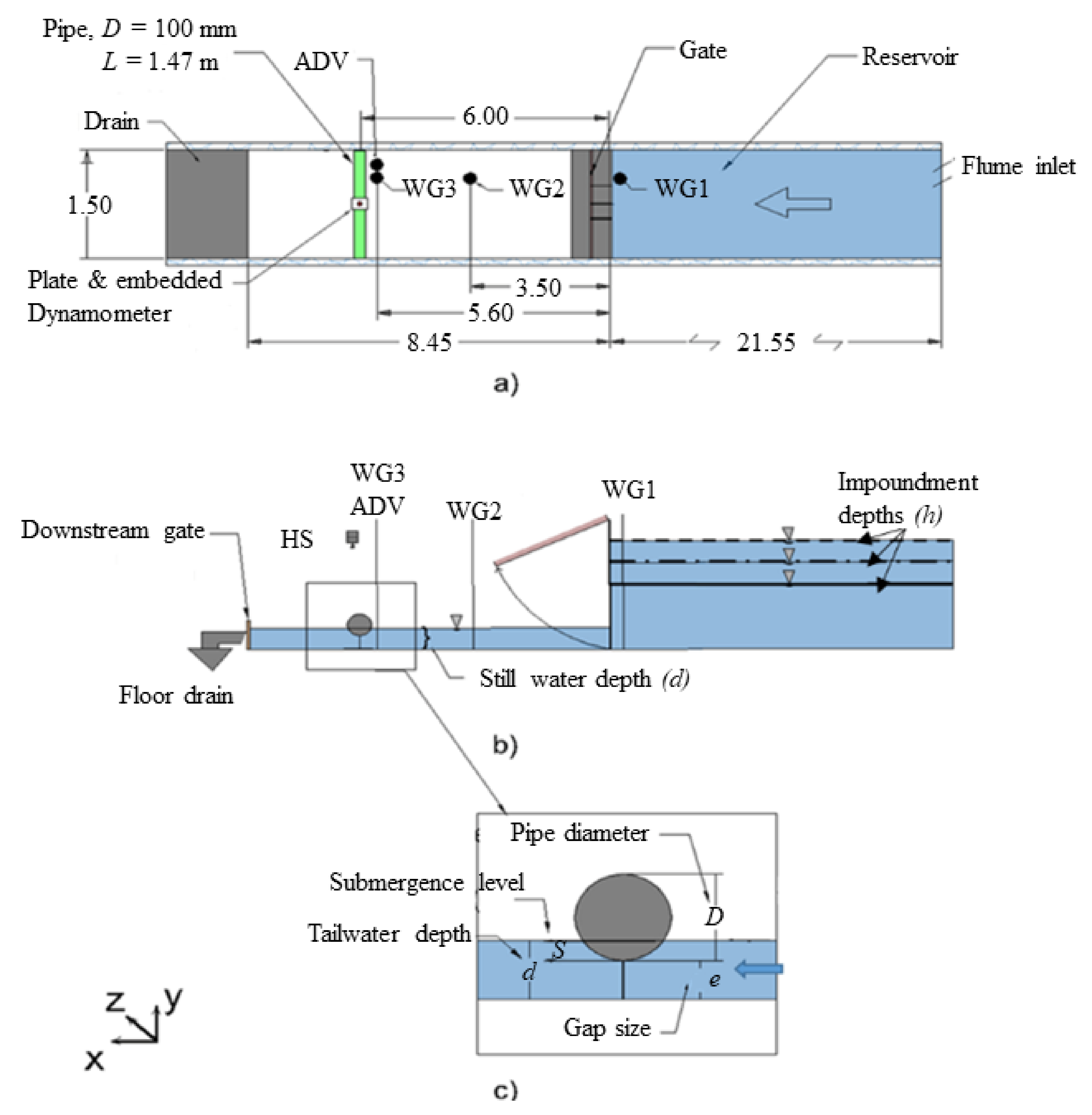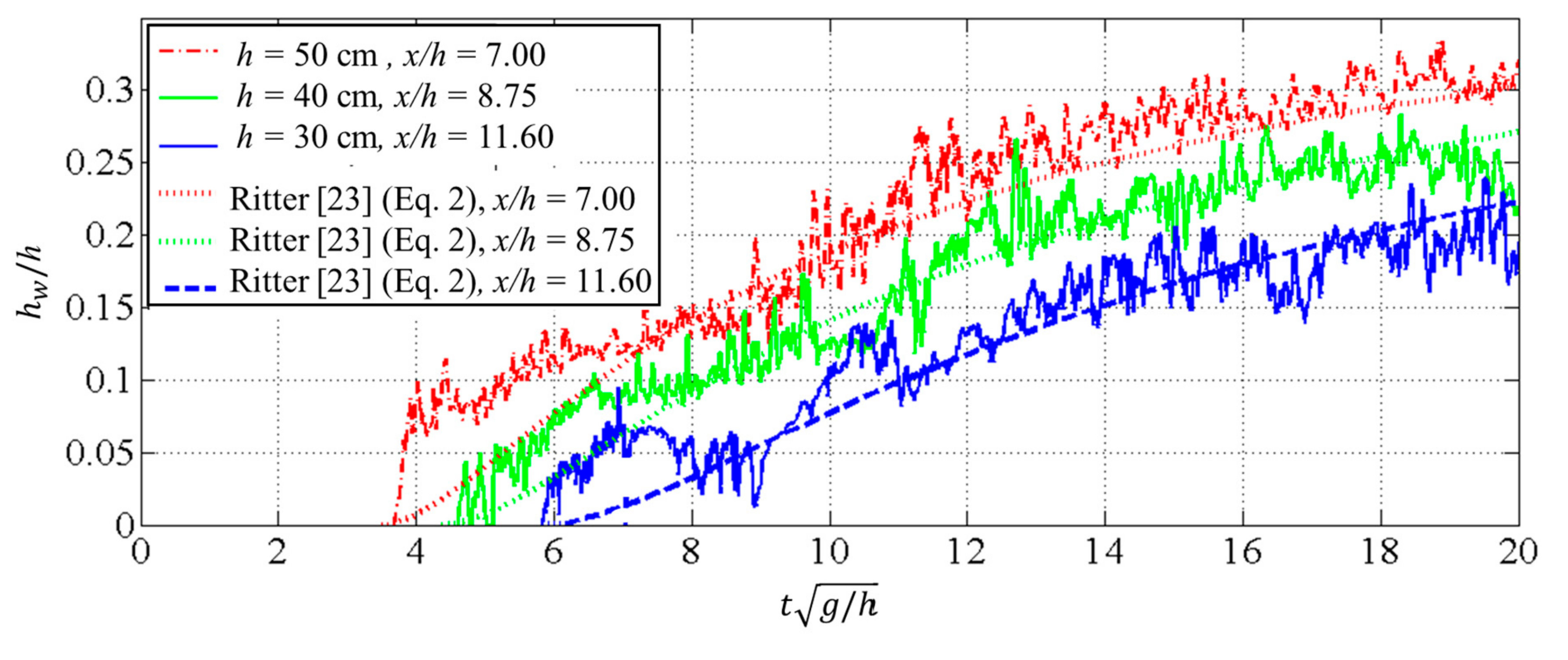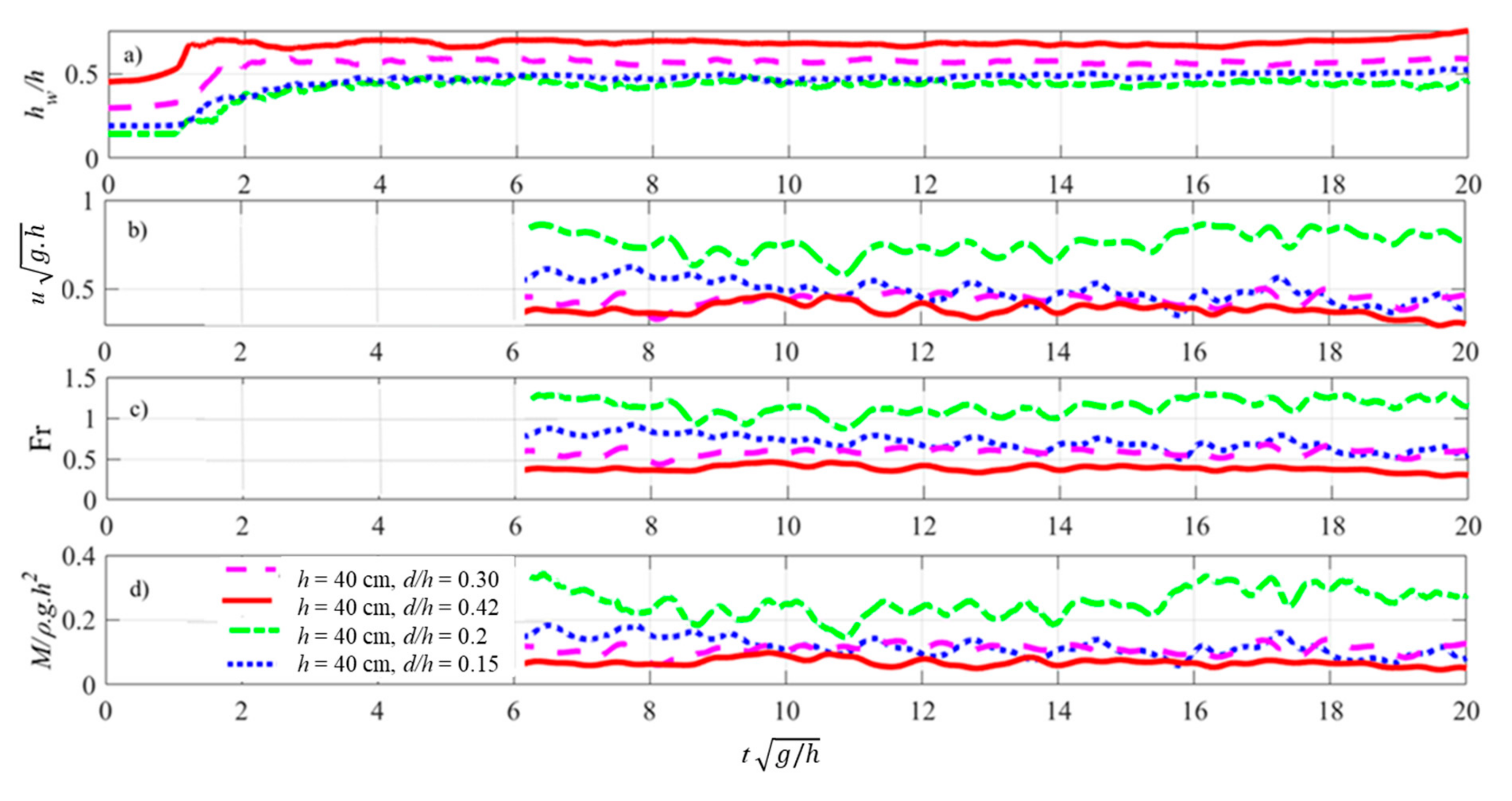Experimental Study on Extreme Hydrodynamic Loading on Pipelines. Part 1: Flow Hydrodynamics
Abstract
:1. Introduction
1.1. Background
1.2. Objectives
- What are the flow characteristics (time-history of the wave surface profile and flow velocity) for dam-break waves propagating over dry bed conditions for different wave heights?
- How are flow characteristics altered in the case of dam-break wave propagation over wet bed (still water on the flume bed, downstream of the impounding gate) and how are these characteristics changing when the dam-break wave height changes and/or when the still water depth of the wet bed varies?
- How do flow conditions get influenced by the presence of a horizontal cylindrical pipe immersed in the flow under both dry and wet bed conditions?
2. Experimental Setup
2.1. Dam-Break Flume
2.2. Instrumentation
2.2.1. Wave Gauges
2.2.2. Acoustic Doppler Velocimeter (ADV)
2.2.3. Dynamometer
2.2.4. Data Acquisition System
2.2.5. Camera
2.2.6. Cylindrical Pipe
2.3. Experimental Test Program
Test Repeatability (Water Level Time History)
3. Results and Discussion
3.1. Dry Bed Condition Hydrodynamics
3.1.1. Dry Bed Water Surface Profile
3.1.2. Dry Bed Bore Front Celerity
3.1.3. Dry Bed Flow Velocity, Froude Number and Momentum Flux
3.2. Wet Bed Condition Hydrodynamics
3.2.1. Wet Bed Water Surface Profile
3.2.2. Wet Bed Bore Front Celerity
3.2.3. Wet Bed Flow Velocity, Froude Number and Momentum Flux
3.3. Changes in Hydrodynamic Conditions Due to the Presence of the Pipe
3.3.1. Dry Bed Condition
Influence of Pipe Gap Ratio (e/D) in Dry Bed Condition
Influence of Impoundment Depth
3.3.2. Wet Bed Condition
Influences of Changing Still Water Depth (d) and Submergence Ratio (S/D)
3.4. Scale Effects
4. Conclusions
- For the dry bed condition, the bore front celerity increased with an increase in the impoundment depth. α = 1.2 was suggested to be used in Equation (4) for the bore front celerity expression.
- The water surface profile and flow velocity, as well as the flow Froude number, were shown to change more gradually over the same period of time for small impoundment depths (i.e., h = 30 cm) compared to the waves generated by higher impoundment depths. Momentum flux was also smaller in the wave front region for h = 30 cm, due to a smaller flow velocity and water depth.
- Increasing the still water level downstream of the gate led to slower bore flow velocities, reduced Froude number, and reduced momentum flux compared to the bore produced by the same impoundment depth, but propagating over the dry bed. The flow regime changes from supercritical to subcritical with an increase in the still water depth and for d/h > 0.3.
- The presence of the pipe, for both dry and wet bed condition, caused the water level to rise and the flow velocity to decrease. In dry bed condition, smaller e/D values resulted in more abrupt water level rise at the time of the bore impact and a faster decrease in flow velocity.
- For bore propagating over dry bed, the water level increase at the time of bore impact in the presence of the pipe became larger with an increasing impoundment depth.
- In the case of the wet bed condition, increased level of pipe submergence S/D, due to increasing the still water depth d resulted in a reduction of the influence of the pipe on flow hydrodynamics. This was explained by a reduction in the flow blockage, due to the increased pipe submergence.
Author Contributions
Funding
Acknowledgments
Conflicts of Interest
References
- Nicholls, R.J. Coastal flooding and wetland loss in the 21st century: Changes under the SRES climate and socio-economic scenarios. Glob. Environ. Change 2004, 1, 69–86. [Google Scholar] [CrossRef]
- Cao, Z.; Yue, Z.; Pender, G. Landslide dam failure and flood hydraulics. Part I: Experimental investigation. Nat. Hazards 2011, 2, 1003–1019. [Google Scholar] [CrossRef]
- Prasad, S. Wave Impact Forces on a Horizontal Cylinder. Ph.D. Dissertation, University of British, Columbia, UK, 1994. [Google Scholar]
- Matsutomi, H.; Okamoto, K. Inundation flow velocity of tsunami on land. Island Arc. 2010, 3, 443–457. [Google Scholar] [CrossRef]
- Dias, P.; Dissanayake, R.; Chandratilake, R. Lessons Learned from Tsunami Damage in Sri Lanka. Civil Eng. 2006, 159, 74–81. [Google Scholar] [CrossRef]
- Rossetto, T.; Peiris, N.; Pomonis, A.; Wilkinson, S.M.; Re, D.; Koo, R.; Gallocher, S. The Indian Ocean tsunami of December 26, 2004: Observations in Sri Lanka and Thailand. Nat. Hazards. 2007, 1, 105–124. [Google Scholar] [CrossRef]
- Jaffe, B.E.; Goto, K.; Sugawara, D.; Richmond, B.M.; Fujino, S.; Nishimura, Y. Flow speed estimated by inverse modeling of sandy tsunami deposits: Results from the 11 March 2011 tsunami on the coastal plain near the Sendai Airport, Honshu, Japan. Sediment. Geol. 2012, 282, 90–109. [Google Scholar] [CrossRef]
- Fritz, H.M.; Phillips, D.A.; Okayasu, A.; Shimozono, T.; Liu, H.; Mohammed, F.; Skanavis, V.; Synolakis, C.E.; Takahashi, T. The 2011 Japan tsunami current velocity measurements from survivor videos at Kesennuma Bay using LiDAR. Geophys. Res. Lett. 2012, 39. [Google Scholar] [CrossRef]
- Limura, K.; Norio, T. Numerical simulation estimating effects of tree density distribution in coastal forest on tsunami mitigation. Ocean Eng. 2012, 54, 223–232. [Google Scholar] [CrossRef]
- Synolakis, C.E. The run-up of solitary waves. J. Fluid Mech. 1987, 185, 523–545. [Google Scholar] [CrossRef]
- Gedik, N.; Irtem, E.; Kabdasli, S. Laboratory investigation on tsunami run-up. Ocean Eng. 2005, 32, 513–528. [Google Scholar] [CrossRef]
- Hsiao, S.C.; Lin, T.C. Tsunami-like solitary waves impinging and overtopping an impermeable seawall: Experiment and RANS modeling. Coast. Eng. 2010, 57, 1–18. [Google Scholar] [CrossRef]
- Aristodeme, F.; Tripepi, G.; Meringolo, D.D.; Veltri, P. Solitary wave-induced forces on horizontal circular cylinders: Laboratory experiments and SPH simulations. Coast. Eng. 2017, 129, 17–35. [Google Scholar] [CrossRef]
- Madsen, A.; Schäffer, H.A. Analytical solutions for tsunami run-up on a plane beach: Single waves, N-waves and transient waves. J. Fluid Mech. 2010, 645, 27–57. [Google Scholar] [CrossRef]
- Madsen, A.; Fuhrman, D.R.; Schäffer, H.A. On the solitary wave paradigm for tsunamis. J. Geophys. Res. 2008, 113, 286–292. [Google Scholar] [CrossRef]
- Chan, I.C.; Liu, L.F. On the run-up of long waves on a plane beach. J. Geophys. Res. 2012, 117, 72–82. [Google Scholar] [CrossRef]
- Leschka, S.; Oumeraci, H. Solitary waves and bores passing three cylinders-effect of distance and arrangement. Coast. Eng. Proc. 2014, 1, 23. [Google Scholar] [CrossRef]
- Istrati, D.; Buckle, I.; Lomonaco, P.; Yim, S. Deciphering the tsunami wave impact and associated connection forces in open-girder coastal bridges. J. Mar. Sci. Eng. 2018, 6, 148. [Google Scholar] [CrossRef]
- Zhao, E.; Qu, K.; Mu, L.; Kraatz, S.; Shi, B. Numerical study on the hydrodynamic characteristics of submarine pipelines under the impact of real-world tsunami-like waves. Water 2019, 11, 221. [Google Scholar] [CrossRef]
- Chanson, H.; Aoki, S.I.; Maruyama, M. An experimental study of tsunami runup on dry and wet horizontal coastlines. Sci. Tsunami Hazards 2003, 20, 278–293. [Google Scholar]
- Chanson, H. Tsunami surges on dry coastal plains: Application of dam break wave equations. Coast. Eng. J. 2006, 48, 355–370. [Google Scholar] [CrossRef]
- Stolle, J.; Ghodoosipour, B.; Derschum, C.; Nistor, I.; Petriu, E.; Goseberg, N. Swing gate generated dam-break waves. J. Hydraul. Res. 2018, 1–13. [Google Scholar] [CrossRef]
- Ritter, A. Die Fortpflanzung der Wasserwellen. Z Des. Vereines Dtsch. Ingenieure 1892, 36, 947–954. [Google Scholar]
- Henderson, F.M. Open Channel Flow; MacMillan Company: New York, NY, USA, 1966. [Google Scholar]
- Chanson, H. Applications of the Saint-Venant equations and method of characteristics to the dam break wave problem. Hydraul. Model Rep. 2005, 47, 41–49. [Google Scholar] [CrossRef]
- Wüthrich, D.; Pfister, M.; Nistor, I.; Schleiss, A.J. Experimental study of tsunami-like waves generated with a vertical release technique on dry and wet beds. J. Water W Port Coast 2018, 4, 04018006. [Google Scholar] [CrossRef]
- St-Germain, P.; Nistor, I.; Townsend, R.; Shibayama, T. Smoothed-particle hydrodynamics numerical modelling of structures impacted by tsunami bores. J. Water W Port Coast 2013, 1, 66–81. [Google Scholar]
- Douglas, S.; Nistor, I. On the effect of bed condition on the development of tsunami-induced loading on structures using OpenFOAM. Nat. Hazards 2015, 2, 1335–1356. [Google Scholar] [CrossRef]
- Nouri, Y.; Nistor, I.; Palermo, D. Experimental investigation of tsunami impact on free standing structures. Coast. Eng. J. 2010, 52, 43–70. [Google Scholar] [CrossRef]
- Al-Faesly, T.; Palermo, D.; Nistor, I.; Cornett, A. Experimental modeling of extreme hydrodynamic forces on structural models. Int. J. Pro. Str. 2012, 3, 477–506. [Google Scholar] [CrossRef]
- Bremm, G.C.; Goseberg, N.; Schlurmann, T.; Nistor, I. Long wave flow interaction with a single square structure on a sloping beach. J. Mar. Sci. Eng. 2015, 3, 821–844. [Google Scholar] [CrossRef]
- Foster, A.S.J.; Rossetto, T.; Allsop, W. An experimentally validated approach for evaluating tsunami inundation forces on rectangular buildings. Coast. Eng. J. 2017, 128, 44–57. [Google Scholar] [CrossRef]
- Wüthrich, D.; Pfister, M.; Nistor, I.; Schleiss, A.J. Experimental study on the hydrodynamic impact of tsunami-like waves against impervious free-standing buildings. Coast. Eng. J. 2018, 60, 180–199. [Google Scholar] [CrossRef]
- Wüthrich, D.; Pfister, M.; Nistor, I.; Schleiss, A.J. Experimental study on forces exerted on buildings with openings due to extreme hydrodynamic events. Coast. Eng. J. 2018, 140, 72–86. [Google Scholar] [CrossRef]
- Arnason, H. Interactions Between an Incident Bore and a Free-Standing Coastal Structure. Ph.D. Dissertation, University of Washington, Seattle, WA, USA, 2005. [Google Scholar]
- Goseberg, N.; Schlurmann, T. Non-stationary flow around buildings during run-up of tsunami waves on a plain beach. In Proceedings of the Coastal Engineering Conference, American Society of Civil Engineers (ASCE), Reston, VA, USA, 15–20 June 2014. [Google Scholar]
- Araki, S.; Deguchi, I. Characteristics of wave pressure and fluid force acting on bridge beam by tsunami. Coast. Struct. 2011, 1299–1310. [Google Scholar] [CrossRef]
- Mazinani, I.; Ismail, Z.; Hashim, A.M.; Saba, A. Experimental investigation on tsunami acting on bridges. Int. J. Civ. Env. Eng. 2014, 8, 1040–1043. [Google Scholar]
- Chen, C.; Melville, B.W.; Nandasena, N.A.K.; Farvizi, F. An experimental investigation of tsunami bore impacts on a coastal bridge model with different contraction ratios. J. Coast. Res. 2017, 34, 460–469. [Google Scholar] [CrossRef]
- Louis, S.T. Missouri Minimum Design Loads and Associated Criteria for Buildings and Other Structures; ASCE/SEI (ASCE/Structural Engineering Institute): Reston, VA, USA, 2017; pp. 25–50. [Google Scholar]
- Ghodoosipour, B.; Stolle, J.; Nistor, I.; Mohammadian, A.; Goseberg, N. Experimental study on extreme hydrodynamic loading on pipelines part 2: Induced force analysis. JMSE 2019. [Google Scholar]
- Lauber, G.; Hager, W.H. Experiments to dam break wave: Horizontal channel. J. Hydraul. Res. 1998, 3, 291–307. [Google Scholar] [CrossRef]
- Stoker, J.J. Water Waves: The Mathematical Theory with Applications; John Wiley Sons: Hoboken, NJ, USA, 1958. [Google Scholar]
- Bricker, J.D. On the need for larger Manning’s roughness coefficients in depth-integrated tsunami inundation models. Coast. Eng. J. 2015, 57, 1550005. [Google Scholar] [CrossRef]
- Peakall, J.; Warburton, J. Surface tension in small hydraulic river models- The significance of the Weber number. J. Hydrol. (New Zealand) 1998, 35, 199–212. [Google Scholar]
- Chow, V. Open Channel Hydraulics; McGraw-Hill Book Company, Inc.: New York, NY, USA, 1959. [Google Scholar]
- Sumer, B.M.; Fredsøe, J. Hydrodynamics Around Cylindrical Structures; World Scientific Publishing Company: Singapore, 2006. [Google Scholar]

















| Reservoir Depth h (m) | Still Water Depth d (m) | Head Ratio d/h (-) | |
|---|---|---|---|
| Hydrodynamic test (no pipe) | 0.3 | 0 | 0 |
| 0.03 | 0.1 | ||
| 0.06 | 0.2 | ||
| 0.08 | 0.26 | ||
| 0.12 | 0.4 | ||
| 0.17 | 0.56 | ||
| Hydrodynamic test (no pipe) | 0.4 | 0 | 0 |
| 0.03 | 0.075 | ||
| 0.06 | 0.15 | ||
| 0.08 | 0.2 | ||
| 0.12 | 0.3 | ||
| 0.17 | 0.425 | ||
| Hydrodynamic test (no pipe) | 0.5 | 0 | 0 |
| 0.03 | 0.06 | ||
| 0.06 | 0.12 | ||
| 0.08 | 0.16 | ||
| 0.12 | 0.24 | ||
| 0.17 | 0.34 |
| Gap Ratio e/D (-) | Reservoir Depth h (m) | Still Water Depth d (m) | Head Ratio d/h (-) | Level of Submergence Ratio S/D (-) |
|---|---|---|---|---|
| 0.3 | 0.3 | 0 | 0 | 0 |
| 0.40 | 0.03 | 0.1 | 0 | |
| 0.50 | 0.06 | 0.2 | 0.3 | |
| 0.6 | 0.30 | 0.08 | 0.26 | 0.5 |
| 0.40 | 0.12 | 0.4 | 1 | |
| 0.4 | 0 | 0 | 0 | |
| 0.8 | 0.30 | 0.03 | 0.075 | 0 |
| 0.40 | 0.06 | 0.15 | 0.3 | |
| 0.50 | 0.08 | 0.2 | 0.5 |
| Reservoir Depth h (m) | Head Ratio d/h | Maximum Wave Height (m) | Wave Front Celerity (m/s) | Weber Number (-) | Flow Reynolds Number (-) | Pipe Reynolds Number (-) |
|---|---|---|---|---|---|---|
| 0.3 | 0.00 | 0.078 | 2.00 | 4285 | ||
| 0.200 | 0.100 | 1.41 | 2730 | |||
| 0.260 | 0.107 | 1.53 | 3440 | |||
| 0.400 | 0.136 | 1.35 | 3404 | |||
| 0.560 | 0.163 | 1.67 | 6244 | |||
| 0.4 | 0.000 | 0.128 | 2.27 | 9060 | ||
| 0.150 | 0.172 | 1.68 | 6688 | |||
| 0.200 | 0.176 | 1.53 | 5660 | |||
| 0.300 | 0.224 | 1.48 | 6739 | |||
| 0.425 | 0.268 | 1.67 | 10,266 | |||
| 0.5 | 0.000 | 0.160 | 2.60 | 14,857 | ||
| 0.120 | 0.215 | 2.05 | 12,411 | |||
| 0.160 | 0.220 | 1.85 | 10,342 | |||
| 0.240 | 0.280 | 1.79 | 12,323 | |||
| 0.340 | 0.335 | 1.91 | 16,787 |
© 2019 by the authors. Licensee MDPI, Basel, Switzerland. This article is an open access article distributed under the terms and conditions of the Creative Commons Attribution (CC BY) license (http://creativecommons.org/licenses/by/4.0/).
Share and Cite
Ghodoosipour, B.; Stolle, J.; Nistor, I.; Mohammadian, A.; Goseberg, N. Experimental Study on Extreme Hydrodynamic Loading on Pipelines. Part 1: Flow Hydrodynamics. J. Mar. Sci. Eng. 2019, 7, 251. https://doi.org/10.3390/jmse7080251
Ghodoosipour B, Stolle J, Nistor I, Mohammadian A, Goseberg N. Experimental Study on Extreme Hydrodynamic Loading on Pipelines. Part 1: Flow Hydrodynamics. Journal of Marine Science and Engineering. 2019; 7(8):251. https://doi.org/10.3390/jmse7080251
Chicago/Turabian StyleGhodoosipour, Behnaz, Jacob Stolle, Ioan Nistor, Abdolmajid Mohammadian, and Nils Goseberg. 2019. "Experimental Study on Extreme Hydrodynamic Loading on Pipelines. Part 1: Flow Hydrodynamics" Journal of Marine Science and Engineering 7, no. 8: 251. https://doi.org/10.3390/jmse7080251
APA StyleGhodoosipour, B., Stolle, J., Nistor, I., Mohammadian, A., & Goseberg, N. (2019). Experimental Study on Extreme Hydrodynamic Loading on Pipelines. Part 1: Flow Hydrodynamics. Journal of Marine Science and Engineering, 7(8), 251. https://doi.org/10.3390/jmse7080251







